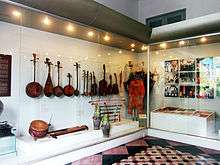Cải lương

Tuồng cải lương (Vietnamese: [tûəŋ ka᷉ːj lɨəŋ], roughly "reformed theater") is a form of modern folk opera in Vietnam. It blends southern Vietnamese folk songs, classical music, hát tuồng (a classical theatre form based on Chinese opera), and modern spoken drama.
History and description
Cải lương originated in Southern Vietnam in the early 20th century and blossomed in the 1930s as a theatre of the middle class during the country's French colonial period. Cải lương is now promoted as a national theatrical form. Unlike the other folk forms, it continued to prove popular with the masses as late as the 1970s and the 1980s, although it is now in decline.[1][2]
Cải lương can be compared to a sort of play with the added aspect of Vọng cổ. This term literally means "nostalgia for the past", it is a special type of singing with the background music often being the đàn tranh zither or the đàn ghi-ta (Vietnamized guitar). In a typical cải lương play, the actresses and actors would use a combination of regular spoken dialogue and vọng cổ to express their thoughts and emotions.
Cải lương normally highlights/praises Vietnamese moral values. There are mainly two types of cải lương: cải lương tuồng cổ (ancient) and cải lương xã hội (modern).

Cải lương xã hội ("society reformed theater" 改良社會) consists of stories about modern Vietnamese society. The plots deal with a romantic love story blended with family or social relationships. The stories also explore cultural norms, social norms, and other aspects of Vietnamese society, e.g. Đời Cô Lựu, Tô Ánh Nguyệt. This type can be somehow described as tragedy, but with a happy ending. However, a few cải lương xã hội such as "Ra Giêng Anh Cưới Em" are comedic and light.
In Cải lương tuồng cổ, The actor/actress dresses in an old fashioned costume. The plot is based on a tale, legend or historical story of the feudal system, where kings and warriors still existed. For example, Bên Cầu Dệt Lụa, Lục Vân Tiên, Tiếng Trống Mê Linh etc. Many plots come from Chinese historic or ancient legends. Lương Sơn Bá-Chúc Anh Đài is based on the Chinese legend of butterfly lovers. In Cải lương tuồng cổ, Hồ Quảng a kind of Chinese opera may be mixed. Hence, some Cải lương tuồng cổ may be called Cải lương Hồ Quảng, which is more like a musical. In addition to regular speech, ca cải lương, and Vọng cổ, several melodies are incorporated into the play . These melodies are reused through different plays, however the words are changed to fit the context of the plays. Cải lương tuồng cổ can be characterized by beautiful, elaborate costumes comprising beautiful and colorful dress pieces; large, beautiful glittery hairpieces; elaborate warrior armor; and elaborate warrior head pieces.
Notable singers
Before 1975
- Phùng Há (1911-2009)
- Út Trà Ôn (1919-2001)
- Le Thanh Tri (1924-2002)
- Hữu Phước (1932-1997)
- Thành Được (born 1934)
- Hùng Cường (1936-1996)
- Út Bạch Lan (1935-2016)
- Tấn Tài (1938-2011)
- Thanh Nga (1942-1978)
- Thanh Thanh Hoa (1943-2009)
- Thanh Sang (1943-2017)
- Minh Phụng (1944-2008)
- Ngọc Giàu (born 1945)
- Bạch Tuyết (born 1945)
- Phượng Liên (born 1947)
- Lệ Thủy (born 1948)
- Minh Vương (born 1950)
- Mỹ Châu (born 1950)
After 1975
- Vũ Linh
- Tài Linh
- Phượng Mai
- Hương Lan
- Châu Thanh
- Phương Hồng Thủy
- Linh Tâm
- Thanh Thanh Tâm
- Kim Tử Long
- Thoại Mỹ
- Vũ Luân
- Ngọc Huyền
- Thanh Ngân
- Trọng Phúc
- Kim Tiểu Long
See also
- Music of Vietnam
- Cao Van Lau songwriter
- Dạ cổ hoài lang "Night song of the missing husband" 1919
- Vọng cổ "nostalgia"
- Culture of Vietnam
- History of Vietnam
References
- ↑ "Archived copy". Archived from the original on 1 October 2008. Retrieved 2008-11-12. Mekong Delta nostalgic for cai luong’s golden days. 21 July 2007
- ↑ "Archived copy". Archived from the original on 3 November 2008. Retrieved 2008-11-12. Beyond remedy for Cai luong. VietNamNet Bridge. 21 August 2008
External links
| Wikimedia Commons has media related to Cải lương. |
- Encyclopedia of Vietnamese Music (wiki)
- Cai Luong Vietnam
- Dan Ca Viet
- Video cai luong
- The best reformed theater songs | Các bài tân cổ cải lương hay nhất